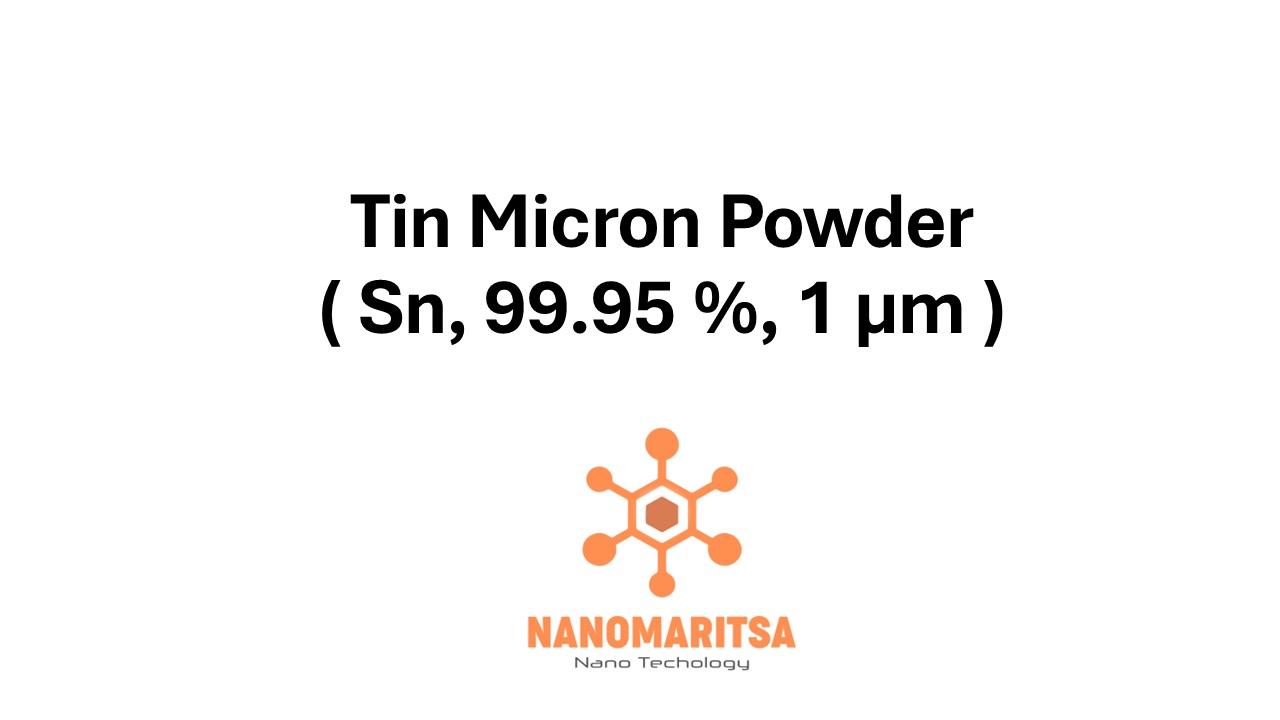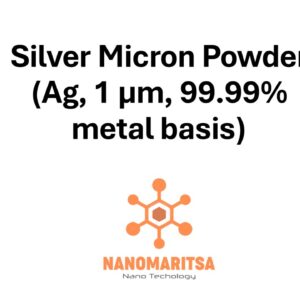Tin Micron Powder (Sn, 99.95%, 1 µm) is a high-purity tin powder featuring a tightly controlled particle size of approximately 1 micrometer. The ultrafine nature of this powder provides a significant surface area, improving reactivity and promoting uniform dispersion in advanced manufacturing processes such as powder metallurgy, solder fabrication, and electronic component production. With a purity level of 99.95%, it meets the strict quality requirements of industries that demand low contamination and consistent performance, including electronics, automotive, and packaging.
- Key Properties
- High Purity (99.95%)
This level of purity minimizes the presence of unwanted impurities, ensuring consistent behavior and performance in sensitive applications like circuit board production and precision coatings. - Ultrafine Particle Size (1 µm)
The small particle size delivers a substantial surface area, which enhances solder wetting, promotes efficient chemical reactions, and eases blending in composite materials. - Low Melting Point
Tin melts at a relatively low temperature (~232 °C), making it indispensable for soldering and brazing where controlled bonding is critical. - Ductility and Malleability
Tin’s inherent ductility facilitates forming processes, providing flexibility and resilience in thin coatings or soldered joints. - Oxidation Resistance
While tin can oxidize, its overall resistance to many forms of corrosion increases durability in coating and plating applications.
- High Purity (99.95%)
- Applications
- Soldering and Brazing
Tin’s low melting point, combined with its wettability and high purity, makes it a common base for lead-free solder alloys and specialized solders in electronics manufacturing. - Electronics & PCB Assembly
Fine tin powder is critical in surface-mount technology (SMT) and integrated circuit packaging, helping achieve accurate and reliable interconnects. - Coatings & Plating
Tin plating offers corrosion protection and a smooth, conductive surface, often used for food-safe packaging, electrical contacts, and decorative finishes. - Powder Metallurgy
Used to produce near-net-shape components with specific mechanical or thermal properties, tin powder can serve as a binder or alloying element in various metal systems. - Additive Manufacturing (3D Printing)
Although less common than other metals, tin powder has potential in developing 3D printed components, especially where low-temperature fusing and good flowability are desired.
- Soldering and Brazing
- Advantages
- Improved Reactivity
The ultrafine powder size increases contact area and promotes efficient chemical or metallurgical reactions, beneficial in solder pastes and specialized alloys. - Uniform Dispersion
Consistent submicron particle size distribution helps maintain homogeneity in composites, ensuring reliable part quality and repeatable properties. - Enhanced Flow Characteristics
Fine, spherical-like particles aid in smoother flow for powder-based processes, reducing defects and facilitating tighter manufacturing tolerances. - Lead-Free Compliance
As industries transition away from lead-containing solders, high-purity tin powders provide a viable and environmentally safer alternative. - Versatility
Tin’s combination of low melting point, malleability, and corrosion resistance enables a broad spectrum of uses, from electronics to specialty coatings.
- Improved Reactivity
- Recent Trends and Research
- Lead-Free Electronics
Worldwide regulations favor reducing or eliminating lead in solders, sparking research into tin-based alloys that match traditional solder performance while meeting environmental standards. - Advanced Solder Formulations
Research focuses on refining tin-based solder compositions (e.g., Sn-Cu, Sn-Ag) to enhance mechanical strength, thermal fatigue resistance, and reliability for high-end electronic devices. - Nanostructured Coatings
Tin nanoparticles are being investigated for application in anti-corrosion coatings, conductive inks, and flexible electronics, boosting adaptability in emerging technologies. - Batteries and Energy Storage
Studies explore tin-based alloys as potential negative electrode materials for lithium-ion and sodium-ion batteries, aiming to improve energy density and cycle life. - 3D Printing Innovations
Although tin is less common in metal additive manufacturing, ongoing advancements in printer capabilities and material science could expand tin’s role in specialized 3D printing solutions.
- Lead-Free Electronics
- Future Prospects
- High-Reliability Solder Joints
As electronic devices become smaller and more powerful, the demand for robust, fine-pitch solder joints will continue to grow, highlighting the importance of ultrafine tin powders. - Expanded Additive Manufacturing Use
Potential breakthroughs in low-temperature 3D printing may see tin powders playing a larger role in printed electronics, customized heat sinks, and other niche applications. - Sustainable Manufacturing
Environmental regulations and consumer expectations for greener products could boost demand for high-purity tin powders that offer excellent recycling and low-toxicity profiles. - Alloy Diversification
Tailored tin-based alloys will likely emerge for targeted applications—from aerospace to biomedical—where controlled melting ranges and mechanical properties are essential. - Electronics Revolution
As the push for miniaturization, flexibility, and wearability accelerates, tin’s role in micro-soldering, wearable circuitry, and advanced packaging will continue to evolve and expand.
- High-Reliability Solder Joints
By combining a 99.95% purity standard, a 1 µm particle size, and inherent properties such as low melting point and malleability, Tin Micron Powder (Sn, 99.95%, 1 µm) is set to remain a cornerstone material in electronics assembly, precision coatings, and innovative manufacturing processes. Its adaptability, environmental friendliness, and strong performance profile contribute to tin’s enduring importance across high-tech and industrial sectors worldwide.
| Measurement (gr) | 100 grams, 500 grams, 1000 grams |
|---|






